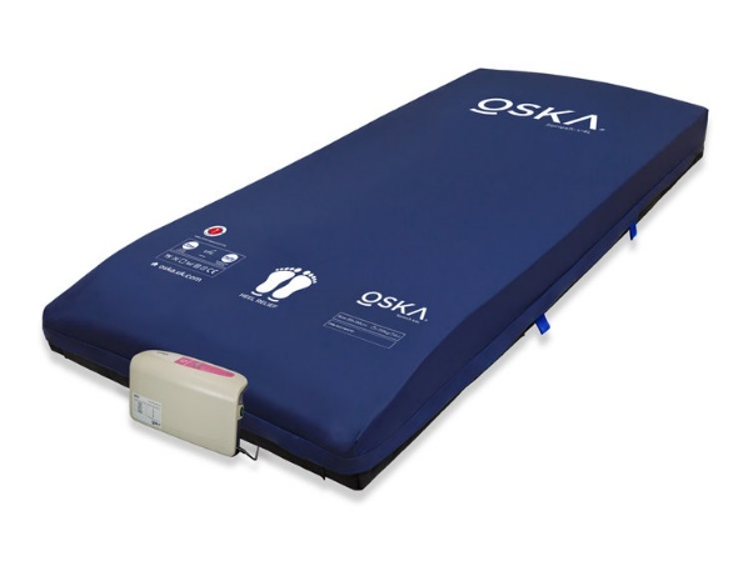There haven’t been many changes to the equipment we use when preventing and managing pressure ulcers for some time, with the more traditional mattresses and cushions becoming familiar sights in hospital and community settings.
But what about the more complex patients that have particular repositioning needs that aren’t met by the traditional equipment that’s available? One example of this patient group are inpatients who require repositioning frequently overnight, but do not have the help to do this at home so remain in hospital to ensure they receive the appropriate care. Such patients are often desperate to go back to their own home. Patients who require palliative care are another patient group for whom comfort, undisturbed periods of rest and minimal disturbance are a high priority. Achieving all this can be challenging with the use of traditional alternating mattresses.
Hybrid mattresses (a combination of foam and alternating air) are commonly used to provide more comfort for patients at risk of developing pressure ulcers but many Tissue Viability Nurses are concerned that these mattresses are not delivering sufficient pressure relief for many category 3 and 4 pressure ulcers.
One answer to these problems is a lateral tilt system. There are several lateral tilt systems on the market, but some have the problem of being too aggressive (the degree of tilt) and patients have reported they feel like they are being tipped out of bed.
But what about the more complex patients that have particular repositioning needs that aren’t met by the traditional equipment that’s available? One example of this patient group are inpatients who require repositioning frequently overnight, but do not have the help to do this at home so remain in hospital to ensure they receive the appropriate care. Such patients are often desperate to go back to their own home. Patients who require palliative care are another patient group for whom comfort, undisturbed periods of rest and minimal disturbance are a high priority. Achieving all this can be challenging with the use of traditional alternating mattresses.
Hybrid mattresses (a combination of foam and alternating air) are commonly used to provide more comfort for patients at risk of developing pressure ulcers but many Tissue Viability Nurses are concerned that these mattresses are not delivering sufficient pressure relief for many category 3 and 4 pressure ulcers.
One answer to these problems is a lateral tilt system. There are several lateral tilt systems on the market, but some have the problem of being too aggressive (the degree of tilt) and patients have reported they feel like they are being tipped out of bed.
What is the OSKA Series5 mattress?
The OSKA Series5 lateral tilt pressure care mattress uses an alternating air and foam combination to provide both comfort and support to people with pressure ulcers. It is suitable as an aid in the prevention, and treatment of, pressure ulcers up to and including category 4.The mattress can be switched from alternating therapy to lateral rotation therapy which gently tilts the patient from side to side every 10 minutes (with 5 minutes on each side), to alternate pressure. This is ideal for palliative care settings or situations where manual turning is difficult.
How does it work?
The inflation system of the mattress consists of four air cylinders that run head to foot underneath the body and the foam topper. These cylinders perform the alternating pressure therapy, and the lateral rotation therapy and they inflate and deflate every 10 minutes. This has been designed to provide and maintain low interface pressures throughout the mattress, making the mattress effective as an aid in the prevention and treatment of pressure ulcers. A simple switch is all that is needed to change the therapy from alternating pressure to lateral rotation.
In the alternating therapy there is an ‘A-B’ sequence of inflation and deflation of the mattress’s four air cylinders designed to change loading across the surface in a 10-minute cycle.


In the lateral rotation therapy two air cylinders on one side inflate, while the two on the opposite side deflate, gently rotating the patient 20° to one side. After 5 minutes, the inflation pattern reverses, and the patient is rotated to the opposite side.


What are the special product features?
There are many other special features which make it even more comfortable and effective for the patient, and easier to use for the healthcare professional.The mattress can deliver an additional measure of shearing protection in the form of the silicone-coated, shear-minimising fabric bands located on the underside of the cover called the Shear Transfer Zones™. This Shear Transfer Zones design helps to;
- Prevent heels, sacrum, and scapula from digging into the surface
- Glide the patient back to their original position following head of bed elevation
- Protect against damaging effects of micro shear, macro shear, and rotational shear
- Provide patient stability by transferring shear to more shear-tolerant anchor points.
The foam topper is a high density, medical grade foam which consists of over 800 individual cells, each of which acts individually to redistribute pressure, to reduce heat and moisture build-up on the skin, and to reduce shear to underlying tissues. This foam topper has a heel protection zone designed to further reduce pressure for the sensitive heel area.
With patient safety at the forefront of design, there is a reinforced wall of foam, called a safety edge, around the outside of the mattress which ensures that patients lying or sitting are directed to the mattress centre, away from the edge and any siderail hazards. If a patient sits on the mattress, they will have their weight redistributed into the centre of the mattress, and so, if the patient was to lose balance and fall the foam wall will help them fall back (onto the mattress) rather than forwards.
How do I install the mattress?
It’s a really simple process to install the mattress. The first step is to place the mattress on the bed frame with the blue fabric side facing up towards the patient with the feet symbol at the foot end of the bed. Then, hang the control unit on the foot board at the end of the bed and connect the airlines to the pump.
When the pump is ON, the unit will power up in ‘Auto Firm’ mode which fills the system with air prior to a patient being placed on it. The pump is then ready to be set in the mode required.
What can the Series5 mattresses do for me and my organisation?
Many clinicians have evaluated the Series5 mattress.Alison Schofield, Tissue Viability Nurse in Community Services, North Lincolnshire and Goole, describes the care of one patient using the mattress. The patient had a category 4 pressure ulcer and was in and out of hospital, spending 12 months out of her own home. It seemed she was going to have to live permanently in a nursing home and she became depressed and stopped eating. She desperately wanted to be in her own home but there were no carers available to deliver overnight repositioning. Using the Series5 in lateral tilt mode led to her pressure ulcer starting to heal, improved her quality of life and meant her sleep wasn’t disturbed. She was up during the day and went out once a week with friends. Alison described how ‘she looked like a different person’.
Sylvie Hampton, Wound Care Consultant Nurse, and Sarah Gray evaluated two mattresses with two patients in a nursing home over a four-week period. The staff found the mattress simple to set up, the slight sound from the pump did not interfere with sleeping, both patients were comfortable, and repositioning was reduced from 2 hourly to every 4-6 hours.
Kelly Lumsden, Senior Charge Nurse, Alexandra Unit in Dumfries used the lateral tilt mode for a patient who had spinal cord compression and lymphoedema who couldn’t lie on his side. Pressure ulcers were starting to develop but there was an improvement when the OSKA Series5 was used.
A Tissue Viability lead in a hospice explains how her pressure ulcer statistics in her hospice have greatly improved since they have been using the mattresses. Based on her experience and the feedback from patients, she would be happy to recommend the mattresses to other service users.
All testimonials are available to view at https://oska.uk.com/
How do I organise a trial of the mattress?
If you would like to organise an evaluation of the Series5 mattresses you can contact OSKA by calling 02394 318 318 or email nurse@oska.uk.com. You can also complete an online form at https://oska.uk.com/products/pressure-care/mattresses/oska-series5/An overview of the OSKA Series5 lateral tilt pressure care can be seen in a short video at https://vimeo.com/335141172

